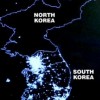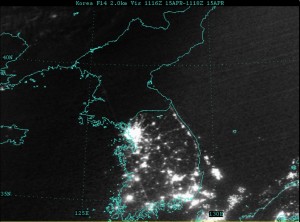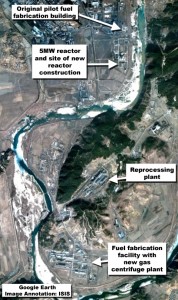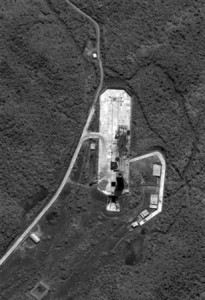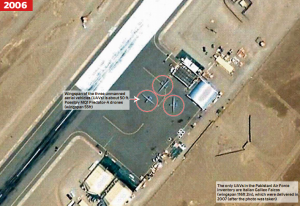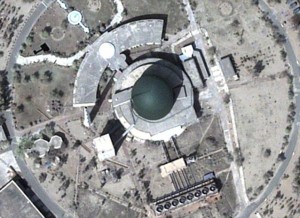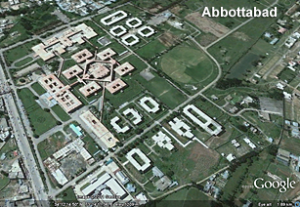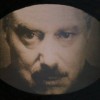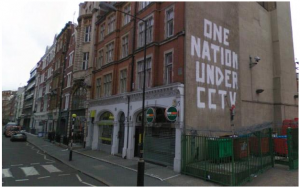“Dark DPRK”
It’s almost obligatory, but here’s our curtain-raiser. I’m most fond of the version without outlines, because if you know what you’re looking at, the absence of light (save for Pyongyang) makes a negative border of North Korea, especially in contrast to South Korea’s island of light below.
Crowdsourcing Surveillance
Curtis Melvin’s “North Korea Uncovered” project is a stunning manifestation of the “forever overhead” thesis. Melvin et al. compile information from myriad sources and label everything they can (prison camps, ostrich farms, nuclear facilities, and Kim Jong-Il’s Neverland-esque water slide)–NoKo-spotting. They’re private analysts somewhat obsessively aggregating a rather serious open-source intelligence resource. Crowdsourcing it, actually: journalists, historians, retired CIA analysts have all contributed. And they’re “just” citizens–anyone with an Internet connection could do this… but now, we can just download the Google Earth KMZ file.
Nukes From Above (Still Lifes, Fortunately)
The Institute for Science and International Security has been acquiring commercial satellite imagery and reporting on the growth of the nuclear facilities at Yongbyon (the last update was yesterday). NKeconwatch has archives of past reports going back to 2008.
While we’re exploring the intersection of the Yongbyon facility and the Forever Overhead topic, a few years ago (2007, when Yongbyon was ostensibly inactive as part of the six-party talks) Satellite Imaging Corporation put together a fun 3D “flythrough” of the compound.
[youtube]http://www.youtube.com/watch?v=x34Y7iZqqEo[/youtube]
Speaking of supervised glimpses inside, IAEA inspections in 2008 to verify the aforementioned shutdown and accounting for all active and spent fuel (as in not being diverted) brought us this raw footage from inside Yongbyon. Note the ubiquitously-paired portraits of Il-Sung and Jong-Il in the control room.
Let’s not forget that the DPRK can exploit our dependence on overhead intelligence to telegraph its intentions (or attempt to get negotiating leverage) as far as nuclear tests; we had news reports based on satellite reconnaissance that North Korea might be preparing to test in May 2005, October 2006 (this one of course did culminate in an actual test), May 2009 (also “true”), even October 2010. Efforts to spoof aerial reconnaissance date back to WWI, but that topic awaits a future post. Of course, one doesn’t need to confine themselves to mere telegraphy, they can always just announce their intentions outright.
Also, back on the topic of judging growth at a distance, Amnesty International has made comparisons of overhead imagery to expose North Korea’s prison camps and the growth thereof.
A Note On Food Aid
Food–particularly the absence of it–is a perennial issue. The 1990s famine . North Koreans men are, on average, shorter than their South Korean counterparts. A US government team is currently in North Korea investigating claims that a new food crisis is underway and whether new requests for aid are founded. There is little doubt that North Koreans are indeed starving; the problem is that the DPRK has a history of “food deceit”, diverting international aid resources, to support its missile and nuclear programs. Food aid to North Korea should be closely monitored and contingent on rejoining–in “good faith”–talks with Le Six.
Another Note on Stolen Glimpses: “Traffic Ladies”
Speaking of stolen glimpses, this is as fine an opportunity as any to mention the “traffic ladies” of Pyongyang (apparently an easy glimpse to steal, given the ubiquity of clips on YouTube–the only reason it took me more than 30 seconds to locate one to share was finding one without a lame sexist title):
[youtube]http://www.youtube.com/watch?v=hDHhW5_RxKc[/youtube]
Postscript: Syria/Al-Kibar
I’m out of juice, but you may remember the Osirak-reverie-inducing destruction of the putative reactor in Syria in . Alas, I’m out of steam and heading out, so for now you’ll have to settle for the company line:
[youtube]http://www.youtube.com/watch?v=4ah6RmcewUM[/youtube]

